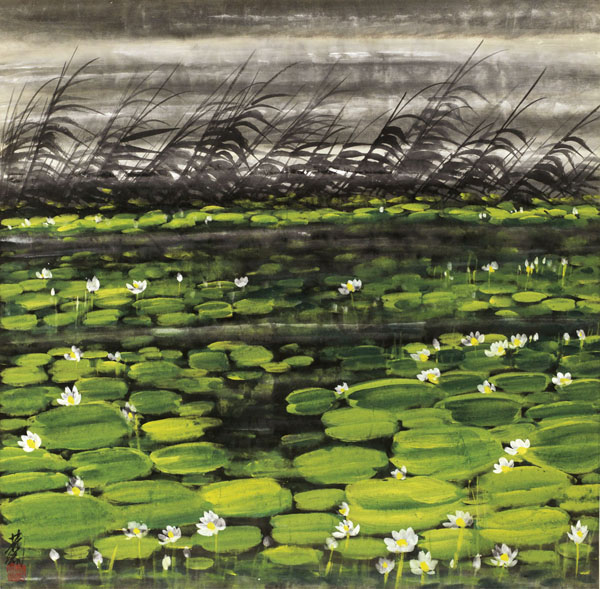A Retrospective Exhibition of Lin Fengmian's 100 Years, Lin & Keng Gallery, Tapiei, 1999, color illustrated, p. 19
|
Lotus Pond
|
|
1960 - 1970 Mounted scroll, ink and color on paper 67 x 69 cm Signed lower left <i>Lin Fengmian</i> in Chinese |
|
Estimate
2,200,000 - 3,200,000 8,470,000 - 12,320,000 280,300 - 407,600
|
|
|
A Retrospective Exhibition of Lin Fengmian's 100 Years, Lin & Keng Gallery, Tapiei, 1999, color illustrated, p. 19
Lin Feng-mian was one of the most important artists of his generation. His successful integration of Western and Chinese painting techniques, and the unique style that he developed, gave his work immense appeal. Lin was also widely admired for his high moral character and his modest, unassuming nature.
"Lotus Pond," which was painted in the 1960s-1970s, is an outstanding example of the emphasis on light and color that characterized Lin's later work, following an earlier period in which he largely adhered to the conventional Chinese landscape painting tradition. Here, Lin's expertise in Western painting techniques can be seen in the reflections, color matching, contrasting of "cold" and "warmth," the sense of space, and the feeling of airiness. Unlike Lin's "still life", "bird and flower" paintings and portraits of women, in his landscapes there is a sense of restraint in the brightness, a feeling of clarity giving way to haziness, and a simplicity that hides unrivalled complexity and richness. In this particular work, the dark background creates a superb contrast with the play of light and color.
This is a classic example of Lin Feng-mian's work from the 1940 – 1970, most of which took the form of paintings on paper that were either square or squarish. The painting also displays the compositional technique that Lin employed in his landscape paintings, which emphasized the use of the "level distance" (one of the "three distances" of traditional Chinese painting), the effect of which is to create a calm, serene atmosphere. When creating this type of work, Lin paid great attention to the depiction of diagonal lines, curved lines and rounded shapes on the horizontal plane; in so doing, he was able to create a feeling of movement and vitality within the overall sense of serenity. In this painting, the reeds bent over at an angle in the wind, the flat surface of the water and of the riverbank, and the repeated oval shapes of the lotus flowers, are arranged with great care to produce an effective contrast between stability and change, stillness and movement. These different elements combine within the painting to form a kind of unity. Within this "variegated unity," the similarities between different forms, the variation in light and color, and the division of two-dimensional space, all have an important role to play in creating the overall effect.
